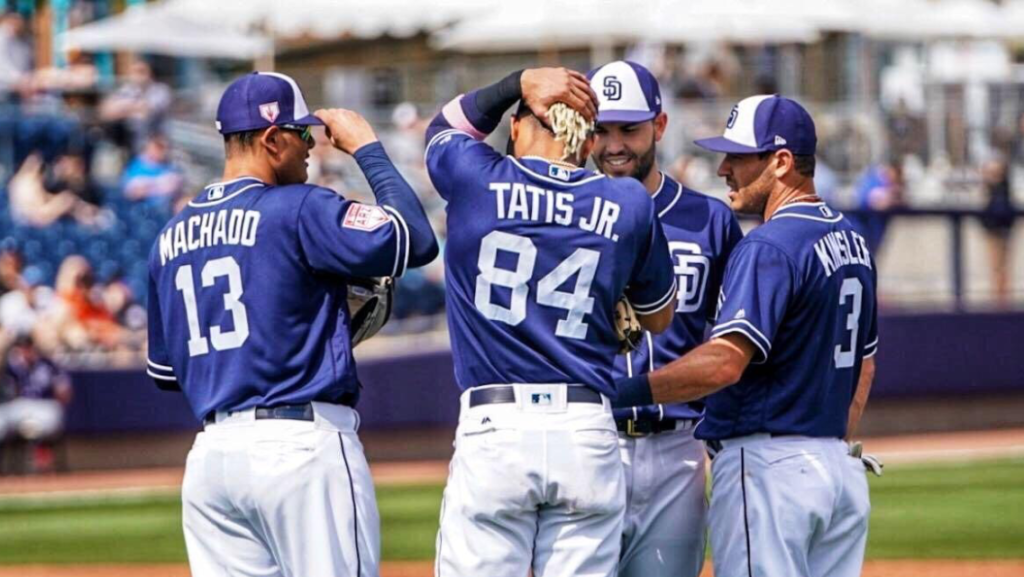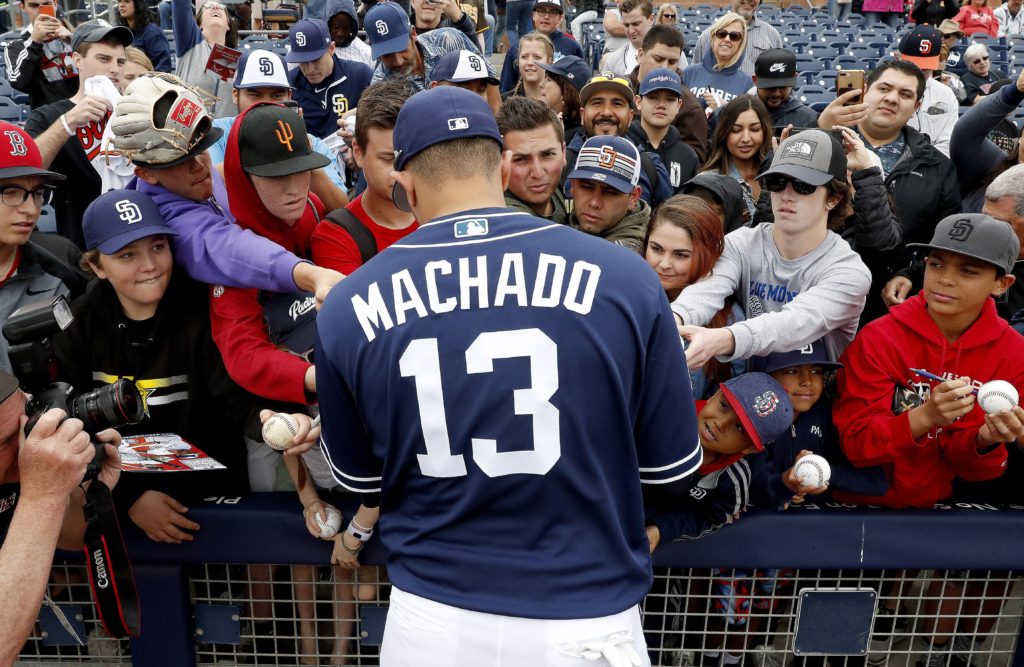The San Diego Padres are Now Playing with Fire

Credit: Padres

The San Diego Padres appear to have an edge now about them. Will this new look result in more wins in the standings?
When he plays for the opposing team, Manny Machado plays dirty. But when he plays for the home team, he plays with an edge.
As the saying goes, beauty is indeed in the eye of the beholder. In truth, it’s about time the San Diego Padres played with a bit of an edge. As Padres players welcomed Machado and his reputation to Peoria, several revealed their desire, indeed their hunger, to add a spark, an edge to the demeanor of the team.
“We need a little fire in the clubhouse,” Travis Jankowski told Keven Acee of the San Diego Union-Tribune. (Machado’s) the kind of player “you hate playing against but you absolutely love him when he’s on your team.”
Catcher Austin Hedges agreed: “We could use some edge and start bullying some people around-as we’ve been bullied for a long time. You can feel it when you face teams that have an edge. We haven’t had it, but I think now we just might.” Hedges said.
Hedges ought to know about being bullied and disrespected. In June 2017 in the sixth inning of a game against the Chicago Cubs, first baseman (and former Padre) Anthony Rizzo tried to score from third on a fly ball with Hedges at the plate. Replays showed the 6-3, 240-pound Rizzo barreling into Hedges. At the time, manager Andy Green called the slide a “fairly egregious violation” of MLB rules.
Hedges agreed, emphasizing that he’d clearly given Rizzo a lane to the plate. Although Chief Baseball Officer Joe Torre called Rizzo to discuss the rule, Major League Baseball did not discipline him in any way. As manager Andy Green said at the time, that kind of inaction leaves catchers particularly vulnerable. But, in the eyes of MLB, this was ANTHONY RIZZO of the CHICAGO CUBS vs. austin hedges of the san diego padres.
It’s also important to note that the genesis of the rule involved a collision at the plate in 2011 between Scott Cousins and BUSTER POSEY of the SAN FRANCISCO GIANTS, another heralded organization. Posey ended up with a broken leg, and baseball launched the “Posey rule.” Had the catcher been a Padre, one doubts that the league would have even bothered.
The additions of Ian Kinsler and Greg Garcia also indicate an organizational push for a new level of intensity. Kinsler will certainly be useful at second (where he’s won a Gold Glove), allowing Luis Urias to play shortstop until Fernando Tatis Jr. arrives. But the Padres also prize the 36-year-olds’ intensity. That intensity has undoubtedly helped a guy drafted in the 17thround to play 13 seasons in the big leagues.
The Boston Red Sox added Kinsler at the trade deadline last year, and pitcher David Price (also a teammate when Kinsler played in Detroit) emphasized to ESPN News Services that “He brings that intensity, that fire every single day. He’s a gamer.”

Infielder Greg Garcia can also help out in the infield, but the five-year veteran comes to the Padres from the St. Louis Cardinals, known for the heralded Cardinal Way. Every single player in the organization receives a handbook detailing high expectations on and off the field, to playing the game the right way.
Garcia recently told James Clark (creator and Editor-in-Chief of the East Village Times), “You look around this room and there is so much talent at such a young age. They are all eager, confident and hungry. Those are things that can make you great. It’s something that can’t be taught. It’s something instilled in them.” Garcia said.
The Padres obviously haven’t gone deep in the playoffs since 1998, when Ken Caminiti led the way in playing with an edge. He played in 146 games in 1996 despite a torn rotator cuff. In his time with the Padres, his body began to break down in other ways, but he left everything on the field every single day. Caminiti’s performance, passion, and sacrifice made him a role model. But he also ruled the clubhouse, and woe to the player that didn’t live up to his standards. Disrespect the manager Bruce Bochy, you just might find your locker emptied and relocated to the big guy’s office.
Most fans remember or have heard of the “Snickers’ Game” played in Monterey, Mexico against the New York Mets in 1996. Despite a serious bout of food poisoning, Caminiti revived enough (thanks to two liters of i.v. fluids) to hit two home runs in his first two at-bats. The Padres won the game 8-0.
The Padres’ teams of that era had the edge, the fire. San Diego may still have that laid-back image, but it should have been shattered by the passion of Padres’ fans in 1984 and 1998.
Today’s fans will respond with similar fervor to a team that plays the game with an edgy vibe.
Baseball has been a part of Diane’s life since her father played professionally (mostly at the minor league level). She has written for a number of publications and concentrated on companion animal welfare. She welcomes the opportunity to write about the sport she loves. Diane shares her home with her husband and a house full of rescued animals.
Diane, I agree with much of what you wrote, here and in other articles, but citing Caminiti as an example of clubhouse leadership is too much.
Good morning Tom,
I understand why you would not see Caminiti as a clubhouse leader, but there is no doubt he was. He was a hard-nosed, leave-it-all-on-the-field kind of guy.
He also had serious substance abuse problems and battled demons during his short lifetime. I tried to get comments from Tim Flannery, but he didn’t get back to me. He’s pretty busy these days with his band… Flannery has been outspoken about cheating and cheaters and is the kind of player most harmed by steroid cheats. But Flan valued Caminiti not only as a teammate but as a friend and even wrote a song about him when he died.
Caminiti started taking steroids (which he got in Mexico), because of his various injuries. That was not the case with guys like Bonds and McGwire (who never should have been hired as Padres’ coach). Then he discovered how much it helped his performance and kept using them.
As a goody two shoes of the first order, I hate cheating. But I also loved watching that man play and the toughness he brought to the Padres. In other words, it’s complicated.
Diane
Caminiti was the worst type of hypocrite. Other players with much more talent have seen their careers evaporate due to injuries. Not all of them then took steroids, not all of them had a reputation of being an angry jerk of a teammate, not all of them set themselves up as the arbiter of how to play the game. I’d rather have a quick to laugh teammate, or someone who was mature enough to realize that how we live is more important than anything else.